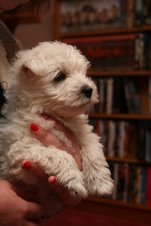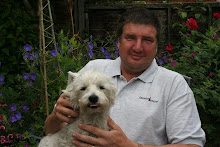 |
Definitely not of marketable quality, a pile of white fleece from
our ewes Lily and Myfanwy. Polly's slatey grey fleece is out of shot. |
Nothing if not a bit of variety in this post - shearing sheep, snatching a beehive under cover of darkness and a bit of a barney in the roosters dept. Read on.
 |
| Not bad - our 3 ewes all looking tidier and a lot cooler |
The sheep shearing is the 'biggest' story from my point of view. It is an important job and one I am trying to learn to do myself but I am finding it hard and difficult work. Last year I tried to do my ewes the 'proper' (professional) way - all that upside down wrestling and sheep on its rump between your legs that you may have seen at Agricultural Shows. It is wearing on the back and, while you are not very good yet, tends to take too long - up to an hour per sheep - for all of which time the poor ewe is under a lot of stress. I finished last year helping friends Sue and Rob by shearing their ewe, 'Pink', who is trained to a head collar and stands upright, on her own feet, reasonably calmly and lets you shear her without any fuss and wrestling. Blow trying to do it the pro way, I decided. I was determined in 2016 to do all ours upright. But head collars for sheep?
 |
The ewes sheared with a bunch of this year's lambs. Goat and
kid in the background. |
Anybody that knows sheep will know that you should really collar-train them from lamb-hood. They are big, strong, heavy animals and do not take kindly to suddenly having a collar round the neck or a halter about the face. They will buck and jump and fight and thrash about, especially if they can see a way out. We were not at all sure that our plan to corral everyone into a tight space while we collared the ewe and then have Liz whispering sweet nothings in the front end while we got a collar on and tied the sheep to some solid cattle-race ironwork, would keep the ewe calm enough when I fired up the noisy, rattling shearer and plunged it into the wool at the back end.
 |
We followed up our own sheep success
by shearing Sue and Rob's ewe, Pink
(here) and Pink's 2015 lamb, the shearling
'Rosie' today. |
Well, in a triumph of calmness, it all went OK. Liz undoubtedly had the harder physical job, hanging onto the rope after she'd "put a turn around" the bars (as we narrow-boaters say!) and steering the sheep's body with a spare knee or hand. I started with a long 'blow' up the spine to open up the fleece and then zizzed out and down in long stripes like mowing a lawn, with the fleece falling away like a cardigan put on backwards. I finished by nipping around legs, under the belly and up the brisket and neck, and finally by shifting the collar down and doing the face.
 |
A Guinea Fowl hurls abuse at everyone
and anyone from our "Howth Head" rock. |
We took around 45 minutes for the first ewe (already much faster than 2015), and then sped up with 35 for the 2nd and 25 for the 3rd. We were covered in lanolin and sweat (plus a bit of poo!) but happy and delighted that the job was over here. I just needed to get over to Sue and Rob's today to tackle Pink again and their shearling ewe (2015 lamb from Pink), Rosie. Now I can clean the machine and put it away for another year. I am quite proud of myself and feel like I am doing OK at this shearing lark.
 |
A second hive collected at night - still needs the straps tidying
away and the roof settling properly. |
I spoke in the last post of our friend and near-neighbour T McC coming out of bees after a sting reaction and dispersing his numerous hives. We had agreed to take one of these so we were back into the joys of trying to safely move a hive containing 20,000+ stinging beasties. Readers who were with me on 13th April 2015 (http://deefer-dawg.blogspot.ie/2015/04/reinforcements.html) will know that you have to do this at night because otherwise all the workers are out foraging and they get left behind. You need to wait till around 22:30 and they have all gone to bed.
 |
| We got 1.764 kg of lovely lean 'parma' ham off our leg. |
The hive is made up of a stack of square boxes which sit on top of each other with no lugs or fixings, so to secure the stack we use gaffer tape all around the joints (to stop the boxes hopping out of line as the car goes over bumps), then ratchet straps over the stack in both directions. The final move is to block the entrance hole with foam and secure with tape, then heft the stack gently onto a wheelbarrow and slowly trundle it to the car. It gets the softest seat in the car (passenger seat) and is lashed to the seat back. You align the hive's internal frames north-south to minimise the slapping if the car brakes - you take all the corners veeeeery gently. You arrive at your destination apiary in pitch darkness and set the hive down on its stand. You gently peel back the foam and tape from the entrance and leg it back indoors. The hive then sits for a few days to settle before you worry about tidying up the remaining tape and straps. In our case it all went well and the ladies were all out doing orientation flights next morning and then normal missions and returns by afternoon. Good luck Hive 2; we hope you will be very happy and content here. Thank you very much T McC.
 |
The Colonel has been in the wars. His face, here, is
spattered with dried blood. |
A while back we had a lovely visit from cousins Dan and Danielle during which Danielle happened to comment on the amusingly creaky 'crow' noise of one of the roosters. We wonder now whether this next story had really started way back then. We have recently kept 2 Buff Orpington roosters. One, The Colonel, we have had for three years; he is our 'alpha'. As back up we allowed one of his children to stay but explained to this lad (The Captain) that as long as he was happy to stay at 2nd-in-Command and did not fight our main man (well, at least as long as he didn't win!) he was a keeper.
 |
The 365 Project is focusing on bio-diversity this week. Our
local crows are all of the 'hooded' variety. |
Well, possibly as a result of the Colonel's loss of manly voice, or maybe the shortage of available hens (several gone broody), the #2 rooster has broken that agreement this week and started attacking The Colonel. This culminated in Liz having to race to his rescue yesterday when The Captain had him down on the ground and was beating the bangers out of him, pecking and kicking. Bad move, Captain.
You cannot leave this kind of thing to run - these are big powerful birds and can do each other serious damage - so we took the not very nice but necessary decision to cull out the young pretender. He is now variously in the freezer as meat, in the bin as feathers and gribbly bits, in the cats as scraps from the stock pot and in a big bottle of stock. RIP Captain. The Colonel is recovering his dignity and pride and looked decidely disconbobulated for the next 24 hours, presumably wondering why his adversary was no longer pouncing on him.












No comments:
Post a Comment